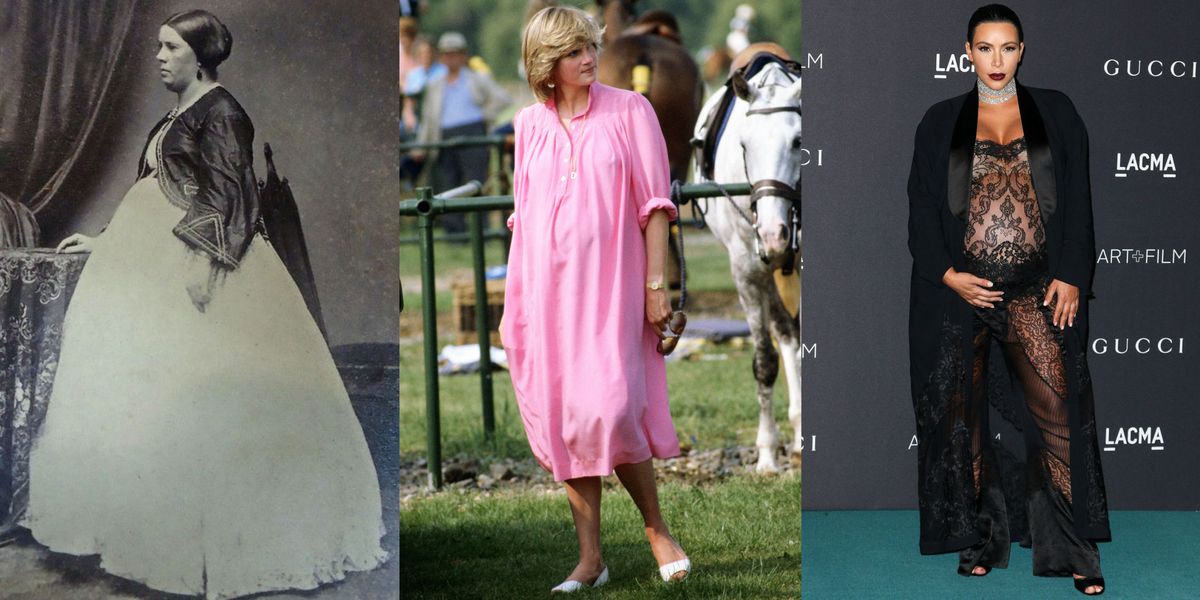Getty Images
From billowing dresses and maternity corsets intended to conceal a woman’s baby bump to the formfitting trend seen on expectant mothers today, see how pregnancy fashion has changed over the years.
1 of 165
1339
Back in the Middle Ages in Europe, women’s everyday dresses were typically full and forgiving enough to readily double as maternity wear. It wasn’t until the early 14th century, when silhouettes started to follow the female form a bit more, that specific design elements were introduced to make clothing more pregnancy-friendly.
2 of 165
1434
Here’s another look at modest maternity style in the 13th century. Heavy materials like velvet became popular for dressing gowns at this time, which helped further conceal bumps.
3 of 165
1460
No seams to take in or let out, just lace-up panels that could be loosened to accommodate a growing baby bump.
4 of 165
1500
Aprons, too, were commonly used to help hide a pregnant belly.
5 of 165
1551
Overcoats had lace-up vents in the back, making them adjustable to fit.
6 of 165
1560s
One of the reasons maternity wear was not as important during the Renaissance era was that during a woman’s later stages of pregnancy, she usually stayed home—meaning she would dress in robes and dressing gowns and had no need for clothing adjustments.
7 of 165
1595
The first recorded maternity gown came about in the Baroque period and was called the “Adrienne,” which featured an empire waist.
8 of 165
1615
The Adrienne style dress also consisted of folds under the waistline and flowing fabric that helped with a growing bump.
9 of 165
1650
By the time we were approaching the Georgian period, the Adrienne dress had evolved to include a bib around the bust to make breastfeeding easier.
10 of 165
1776
As the fashion in the 16th century required petticoats and corsets to attain the ideal figure, many women continued to wear corsets while pregnant.
11 of 165
1786
This dress features slits in the bust to permit women to more easily breastfeed their baby—a duty which was, for most of the 18th century, been delegated to a hired “wet nurse.”
12 of 165
1803
Many women could not afford new clothes while expecting and had to make due with their previous wardrobe. In these cases, when their bump grew so big that letting out their back laces didn’t work anymore, they would wear a shawl or scarf to hide the opening in the back of their dress.
13 of 165
1860
As dresses became fuller into the 1800s, a bump easily blended in with the silhouette.
14 of 165
1860
In the thick of the Victorian era, pregnancy was considered a condition to be concealed. Enter: the maternity corset. This cringe-worthy garment was structured with whalebones and intended to restrict and minimize the appearance of a baby bump. And doctors endorsed them…
15 of 165
1876
The Gossard maternity corset’s slogan promised “Better Babies,” as women were convinced that the contraption would provide exercise that was necessary during pregnancy–while also promising to keep the figure looking trim.
16 of 165
1880
Just add ruffles. No one will notice.
17 of 165
1880
The empire waist is back and this time it’s complemented by a structured, heavy material.
18 of 165
1904
It’s worth noting that most of the maternity style developments to this point were more or less exclusive to wealthy women. Women in poor or working class families typically just wore baggy, oversized dresses during their pregnancies.
19 of 165
1909
“Clothes of Prospective Mothers Should Have Quality of Beauty as Well as of Comfort.” A novel concept, indeed.
20 of 165
1913
Sadly, the maternity corset was still a mainstay for expectant mothers well into the early 1900s.
21 of 165
1920
Benito Mussolini’s pregnant wife sporting the popular empire waist.
22 of 165
1920s
Progressing into the 1920s, maternity style relaxed a tad. Softer silhouettes with draped and belted waistlines were the early signs that confining garb was on its way out.
23 of 165
1920s
But not quickly enough. The mindset of the times was still to hide away any signs of pregnancy. “Be entirely free from embarrassment of a noticeable appearance during a trying period,” said one 1923 maternity wear ad in Good Housekeeping.
24 of 165
1924
The Roaring Twenties brought a welcome reprieve from the restrictive clothes that were popular in decades prior. Just as normal women’s fashion shifted to looser, freer silhouettes, so did maternity fashion.
25 of 165
1925
And women across America breathed a (literal) sigh of relief.
26 of 165
1928
Those drop-waist dresses were the perfect amount of slouchy to accommodate the early stages of a belly.
27 of 165
1930s
The 1930s saw a return of a more conservative standard in mom-to-be style. Feminine waistlines and slim figures were very much in vogue, meaning pregnant women relied on small prints and adjustable waistbands to camouflage their “condition.”
28 of 165
1930s
Flounced necklines, capes, and oversized bows and embellishments helped women hide a bump for a little bit longer.
29 of 165
1930s
Instead of dresses, separates started coming into play in the ’30s. Pleated trapeze tops could be cinched during early months and worn more loosely once a bump started to show.
30 of 165
1934
Small prints, like polka dots, became fashionable for maternity wear, as it was seen as minimizing of a woman’s bump.
Advertisement – Continue Reading Below
Senior Digital Editor, Special Projects
Sarah Lindig is the senior digital editor, overseeing special projects for Harper’s Bazaar.
This content is created and maintained by a third party, and imported onto this page to help users provide their email addresses. You may be able to find more information about this and similar content at piano.io
